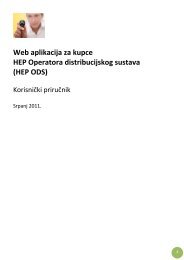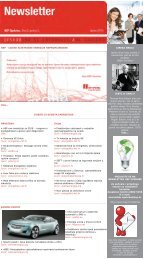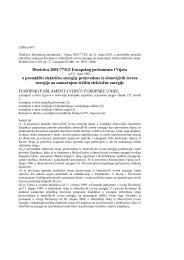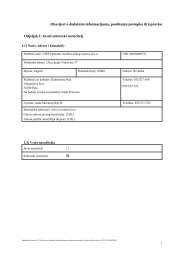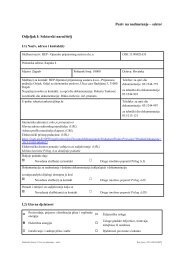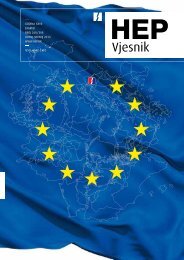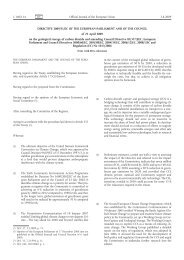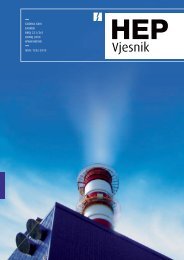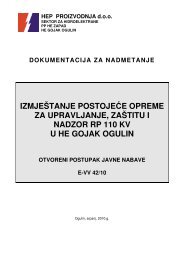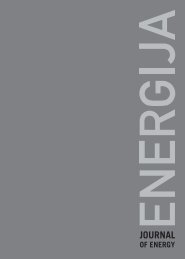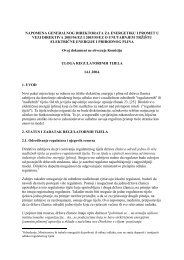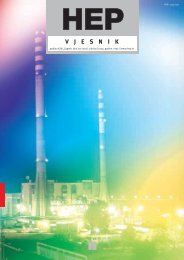You also want an ePaper? Increase the reach of your titles
YUMPU automatically turns print PDFs into web optimized ePapers that Google loves.
Projekt energetske uËinkovitosti pridonosi postizanju<br />
ciljeva utvrappleenih u Direktivi 2006/32/EC<br />
Europskog parlamenta i VijeÊa o uËinkovitom<br />
koriπtenju energije i energetskim uslugama. Cilj je<br />
Direktive uπtedjeti 9 % energije u devetoj godini<br />
primjene energetskih usluga i drugih mjera za<br />
poboljπanje energetske uËinkovitosti.<br />
Zaπtita okoliπa jedan je od glavnih ciljeva Projekta<br />
energetske uËinkovitosti u Hrvatskoj. Projekti<br />
ESCO izravno pridonose zaπtiti okoliπa i potiËu<br />
odræivi razvoj time πto smanjuju potrebe za<br />
proizvodnjom energije i tako smanjuju koliËinu<br />
emisije zagaappleivaËa i otpada. Ovisno o vrsti<br />
projekta, smanjuju se i druge vrste zagaappleivanja<br />
poput svjetlosnog zagaappleivanja od javne rasvjete.<br />
Na globalnoj razini, smanjuju se emisije CO 2<br />
, dok<br />
se lokalno smanjuju ispuπtanja SO 2<br />
, NO x<br />
i Ëestica<br />
u zrak te ispuπtanja zagaappleivaËa u vodu i tlo.<br />
8.3 Obnovljivi izvori energije u Hrvatskoj<br />
TrenutaËno je Hrvatska jedna od zemalja s najviπim<br />
postotkom proizvodnje energije iz obnovljivih<br />
izvora. 35 do 40 posto godiπnje potroπnje<br />
elektriËne energije dolazi od velikih hidroelektrana.<br />
Meappleutim, prodor novih obnovljivih izvora<br />
(vjetar, male hidroelektrane ispod 10 MW, energija<br />
dobivena iz biomase, geotermalna energija,<br />
solarna energija i dr.) joπ je uvijek slab ∑ postoje<br />
samo dvije vjetroelektrane (snage 6 MW i 11 MW)<br />
te nekoliko malih hidroelektrana i elektrana na<br />
otpad.<br />
Stanje je takvo uglavnom zbog nedostatne potpore<br />
proizvodnji elektriËne energije iz obnovljivih<br />
izvora. Od 1. srpnja 2007. i ovaj Êe se problem<br />
poËeti rjeπavati jer je stupio na snagu novi<br />
paket podzakonskih akata kojima Êe se uvesti<br />
sustav zajamËenih cijena za elektriËnu energiju<br />
proizvedenu iz novih obnovljivih izvora energije.<br />
Kvalificirani proizvoappleaËi moÊi Êe dobivati zajam-<br />
Ëene cijene za svaki kilovatsat proizvedene elektriËne<br />
energije iz novih obnovljivih izvora energije<br />
kroz razdoblje od 12 godina od dana kada postanu<br />
povlaπteni proizvoappleaËi [14].<br />
Sredstva za pokriÊe te zajamËene cijene ubirat Êe<br />
se od svih potroπaËa elektriËne energije, time πto<br />
Êe plaÊati izvjestan iznos za svaki utroπeni kWh za<br />
potporu proizvodnji obnovljive elektriËne energije.<br />
Jednim od podzakonskih akata takoappleer se uvodi<br />
obvezna kvota elektriËne energije proizvedene iz<br />
novih obnovljivih izvora energije u 2010. godini<br />
kao udjela ukupne potroπnje elektriËne energije<br />
u toj godini, te se utvrappleuje na 5,8 %. Nakon<br />
ispunjenja kvote od 5,8 % sljedeÊi proizvoappleaËi<br />
neÊe viπe moÊi koristiti zajamËenu cijenu.<br />
services. The aim of the Directive is to save 9 %<br />
of energy in the ninth year of application of energy<br />
services and other measures for energy efficiency<br />
improvement.<br />
Environmental protection is one of the main<br />
objectives of the Energy Efficiency Project in Croatia.<br />
ESCO projects contribute directly to environmental<br />
protection and promote sustainable development<br />
by reducing energy production requirements and<br />
thereby lowering pollutant emissions and waste<br />
quantity. Depending on project type, other types of<br />
pollution are reduced such as light pollution from<br />
public lighting. On the global level, CO 2<br />
emissions<br />
are reduced, whereas locally there is a reduction in<br />
the air emissions of SO 2<br />
, NO x<br />
and particles as well<br />
as the release of pollutants into water and soil.<br />
8.3 Renewable Energy Sources in Croatia<br />
Croatia is currently one of the countries with the<br />
highest percentage of energy production from<br />
renewable sources. 35 % to 40 % of annual<br />
electricity consumption comes from large hydroelectric<br />
power plants. However, the penetration of<br />
new renewable energy sources (wind, small hydro<br />
below 10 MW, biomass, geothermal, solar, etc.)<br />
is still quite weak ∑ there are only two wind power<br />
plants (6 MW and 11 MW of electric power) and a<br />
few small hydro and waste power plants.<br />
This situation is mainly due to the lack of support to<br />
renewable electricity generation. From 1 July 2007,<br />
this problem will also be addressed, as a new set<br />
of bylaws came into effect introducing the feedin<br />
tariff system for electricity generated from new<br />
renewable energy sources. Eligible producers will<br />
be able to receive a guaranteed price for every kWh<br />
of generated electricity from new renewable energy<br />
sources during 12 years from the day of becoming<br />
an eligible producer [14].<br />
Resources for covering the tariff will be collected<br />
from all electricity consumers, as they will pay<br />
a certain amount for each kWh spent toward<br />
renewable electricity.<br />
One of the bylaws also brings the mandatory quota<br />
of electricity produced from new renewable energy<br />
sources in 2010 as the share of total electricity<br />
consumption in that year, and it is set at 5,8 %.<br />
After fulfilling the 5,8 % quota, further producers<br />
will not be able to receive the feed-in tariff.<br />
287<br />
Kennedy,<br />
M. W., StaniÊ, Z., Energetska politika u Europi i..., Energija, god. 56(2007), br. 3., str. 268∑291<br />
Kennedy, M. W., StaniÊ, Z., Energy Policy in Europe and..., Energija, vol. 56(2007), No. 3, pp. 268∑291



